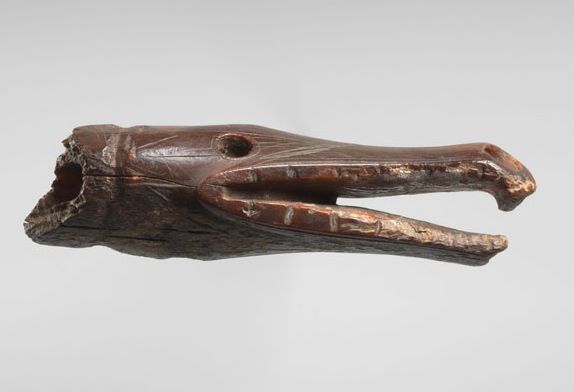
With Upside Down, Edmund Carpenter returns to the Menil in a curatorial role for the first time since 1999, when he and former Menil director Paul Winkler collaborated on Witnesses, the “wunderkammer” installed within the museum’s Surrealism galleries, a collection of ethnographic objects that inspired Surrealist artists. (As a young scholar and explorer, Carpenter made a documentary film about the surrealist qualities of Eskimo masks.) Carpenter has spent decades studying the relationship between the Arctic environment and the array of objects from that vast region. In 1973 he published the seminal Eskimo Realities, exploring indigenous peoples’ sensory relationships with their surroundings and ways in which those relationships were manifested in an art that is at once delicate and utilitarian.
The title of the exhibition, Upside Down, has literal meaning in a land where there are many different words for “snow” and where the white blur of winter can have a profoundly disorienting effect on the uninitiated. As Carpenter writes in the exhibition catalogue, in the Arctic “there is no line dividing earth from sky. The two are of the same substance. There is no middle distance, no perspective, no outline, nothing the eye can cling to…When winds rise and powdery snow fills the air, there is neither up nor down.” Many of the objects on display were meant to be worn or displayed “upside down,” in some cases symbolizing a departure from or an inversion of life.

Carpenter selected Doug Wheeler (b. 1939), a pioneer of the Southern California “Light and Space” movement of the 1960s, to design an evocative environment for the exquisite and powerful works on display in Upside Down. For an earlier incarnation of the exhibition, at the Musée du Quai Branly (the ethnographic art museum in Paris), Wheeler collaborated with architect Jean de Gastines to create an indoor landscape of disorienting scope, devoid of common perceptual signposts like straight lines and definitive shapes. In bringing UPSIDE DOWN to the Menil, Wheeler will totally reconfigure a vast gallery (6,400 square feet), curving the junctures of walls and floors to create the indeterminate “horizon line” one would encounter in the Arctic. Icy neon lighting will cast disorienting glows throughout the space, while sound installations will echo with recordings of cracking ice, calling birds and blowing winds. “I make things that you experience, and then it’s in your mind,” Wheeler has said of his work. “We all have firsthand experiences, and those are the ones we don’t forget. They stay with us and hopefully they’re meaningful enough that they’re with you for the rest of your life.”
Artists – and artwork – of the Arctic offer little distinction between decorative and practical. While many of the objects in Upside Down are everyday wares and tools such as handles, knives, harpoon heads, cooking utensils, combs, and belt buckles, others – like masks and burial objects – embody spiritual beliefs and have ritualistic roles in their cultures.
Carpenter’s research suggests that, in oral cultures like the Eskimo and other Arctic natives, the relationship between artist and medium mattered more than the finished object. Such insights derive from Carpenter’s long exploration of the multi-sensory ways in which oral cultures conceptualize space and how they come to know and understand the world they inhabit.
With Upside Down, Carpenter brings his intellectual voyage full circle, around the whole of the polar icecap and to the indigenous cultures of the Old Bering Sea, from Siberia to Alaska: a world brought stunningly to life in Doug Wheeler’s innovative exhibition design and installation at the Menil.
Source: Art Daily [April 17, 2011]